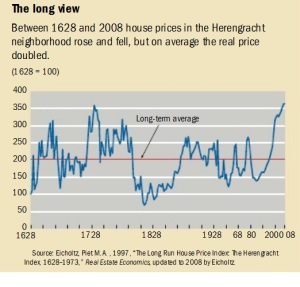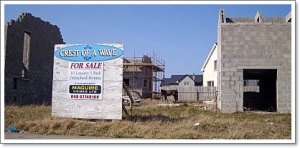The Herengracht house index
One of my favourite pieces of academic research is a study of house prices along the Herengracht canal in Amsterdam made by real estate finance professor Piet Eichholz of Maastricht University. Thanks to outstanding dutch record-keeping, Eichholz managed to construct the Herengracht house index covering house prices from the contruction of the Herengracht in the 1620s all the way to 1975 at first, and later extended to 2008.

The thing with Herengracht is that it never fell out of favour during all these years, it was always (and still is) part of Amsterdam’s most attractive real estate. It was a place where wealthy spice and slave merchants based themselves in the 17th century, and where big banks and consulting firms base themselves today. This makes the Herengracht index a great way of getting an insight in how inflation adjusted real estate prices change over time, and what one can realistically expect in the future.
So what does the Heregracht index show?
Timeline
1620s The Dutch Republic is in its first stage of its rise to global power. With money pouring in and the population doubling in 20 years, the city leaders finally breake an old taboo against building outside the medieval city walls and authorize one of the earliest and most far-reaching urban-planning schemes in history. The Herengracht and two other canals that arc around the city are built.
1628 – 1633 The economy soars. Herengracht house prices doubles. The index begins at 100 in 1628 and reaches 212.7 in 1632
1635 – 1636 Plague hits Amsterdam, kills about 20% of the city’s population.
1637 Tulip mania and subsequent crash. House prices almost drop back to the level of 1628 .
1640s – 1660s Dutch golden age continues. House prices surpass previous highs and reach 314.3 in 1664.
1672 France and England declare war on the Dutch Republic. England hinders Dutch trade on the sea. French king Louis XIV invades over land. Herengracht house prices drop 58% from 268.6 in 1670 to 151.8 in 1678.
1701 – 1714 The war of Spanish Succession devastates the Netherlands. Herengracht house prices drop 16% to 169.5 in 1714.
1720s – 1730s Recovery. Herengracht index reaches a peak of 345.9 in 1736.
1791 United East India Company goes out of business. Herengracht index at 221.9 reflecting an 18th century post golden age decline, and Amsterdam becoming a second tier European city.
1794 France lead by Napoleon invades Holland and captures Amsterdam. Herengracht index drops 74% from 1792 to 1814 where it hits a bottom of 68.1, the lowest value during the entire 380 year period.
1815 Napoleonic wars end. The Dutch reclaim Amsterdam and inaugurate a new monarch, William of Orange. Index begins rise to a peak of 131.4 in 1824.
1839 Amsterdam’s first railway was opens. Index at 125.7
1840s -1890s Economy soars with the industrial revolution. Herengracht index reaches peak of 267.2 in 1886.
1914 – 1918 World War I. Netherlands stays non-aligned, but Herengracht index reaches a war time low of 182.2 in 1916.
1920s Roaring 20s. House prices recover fast after the war reaching 231.7 in 1920 and climbing to 248.8 in 1928.
1930s Worldwide depression. Herengracht index down to 146.6 in 1938.
1940 – 1945 Hitler’s armies reach Amsterdam the 10th of May 1940. Occupation lasts until the Netherlands is liberated by allied forces in 1945. House prices stay at depression lows during the occupation.
1960s Post war boom with index peaks of 245.4 in 1966 and 263.3 in 1970.
1979-1984 Oil crisis Economic downturn. Herengracht index goes below 150.
2000s Global property boom. In 2007 Dutch newspaper Handelsblad reported:
The average house on the Herengracht now costs 2.6 million euros. That is, on an inflation-adjusted basis, just a bit less than in 1736, when house prices along the Herengracht were at their historical high. If house prices keep rising at their current tempo, the 271-year-old record will be tied in 2008.
2008-2010 Property crash. I haven’t seen any Herengracht index data beyond 2008, but I’d guess prices have gone down below 200 again.

Lessons from 380 year of house price data
As the text on the last graph says, over a 380 year period the real (ie inflation adjusted) house prices have only doubled, which corresponds to an annual average price increase of something like 0.1%. And that’s with a starting point just at the start of the Dutch golden age. With a different starting point one could just as well get a 0% or even negative annual price change.
So the conclusion is that there are ups and downs, but that over time prices roughly follow inflation. To expect house prices to rise much faster than inflation every year over a 10 or 20 year period without reverting down again does not make much sense. Guess it’s such expectations that create subprime loan debacles or Irish ghost estates pictured below:
All of this doesn’t mean that real estate is a bad investment over time. A buy to let investor that bought a house on the Herengracht in 1628 would have bought an asset that followed inflation minus costs of maintenance and upgrades, plus getting rental returns of maybe 4% – 8% per year, which well matches good performing stock market returns over long time periods.
Implications for real estate investments in the Ivory Coast
Now there are cases where areas jump up in price and then continue to follow inflation from a higher point. One example would be a transformation from working class low rent area to a sophisticated enclave such as the 20th century transformation of Södermalm in Stockholm, Sweden or Greenwich Village in the US. These types of transformations appear to occur when overall living standards increase and cities expand.
I’d say Herengracht is analogous to the Plateau area in Abidjan. It is attractive and will stay attractive, and prices are likely to have ups and downs along with Ivory Coast’s fortunes, but follow inflation over time.
So the areas to aim for would be those that have a chance of transforming themselves in, say, the next say 30 years. (Unfortunately, human life spans aren’t 380 years long.) In Abidjan, which is a fast growing city with potential for good economic growth, there should be many areas with a chance for a positive transformation. My guess would be at centrally located areas that are below middle class but close to already established wealthy areas. So many parts of Cocody, around Zone 4, and maybe the best parts of Yopougon.
Milwaukee is the exception, not Abidjan
In an excellent article about the Herengracht index from 2006 in the New York Times Magazine, there is a discussion about Amsterdam being a turbulent place and whether it’s representative:
On the face of it, Amsterdam doesn’t seem the most apt model to apply to other cities, particularly American cities. For one thing, the Dutch have a turbulent history. The Low Countries were invaded or occupied many times by foreign powers, with subsequent collapses in the housing market. Also, notes Shiller, “Amsterdam — with tulip mania and the birth of the stock market — is the home of speculation. If you look at, say, Milwaukee, you don’t see the same degree of volatility. In a place like that, price is driven by land availability and construction costs, which is the tradition.”
But then, volatility is more prevalent in world history than stability, which, as far as Eichholtz is concerned, makes the Herengracht data more, rather than less, widely applicable. “The financial literature has been dominated by America,” he said. “And most models are created using post-1950 U.S. data, which give a biased picture of reality. There has been no other country like America, and there has been no other period like that in terms of stability. So I would say that in global terms, Milwaukee is the exception, not Amsterdam.”
From the perspective of Abidjan, it’s easy to agree with the conclusion. The post independence period in the Ivory Coast with booms, busts, coups, civil war, foreign military interventions feels a lot more like historical Amsterdam than Milwaukee.




Hi Martin,
We just met at Craig’s ABFC … I like your blog, i was amazed by the contents and specially your article about the Henregracht index and trying to compare it to Abidjan’s. I agree with you, there are lots of opportunities in this city. Recently for a client, i sold a property on the plateau for 230 mm which was purchased only 15 years ago at 30mm !! I decided to invest in Orlando Florida myself … I t was nice meeting you
Charles
Hi Charles! Indeed nice seeing you! Glad you found your way to my blog and best of luck with your Orlando investment!
hi Martin, such an interesting article. I’d love to see what that chart looks like now with globalization and money printing spurring on house prices almost everywhere. Would you happen to have a current chart for inflation adjusted Herengracht house prices?
thanks, Louisa
Pingback: Abidjan is the 6th largest city in Africa « Hotel Ivory
Pingback: Empty houses « Hotel Ivory
Pingback: A Hundred-Year Old House « Hotel Ivory
Pingback: Boligprisene fra 1628 til i dag » BobleNorge
Pingback: » The Long View on Real Estate - Blog of the Long Now
Together with the whole thing which seems to be building throughout this subject material, your perspectives tend to be
somewhat exciting. On the other hand, I beg your pardon, because I can not subscribe to your whole suggestion, all be it exhilarating none the less.
It looks to everyone that your opinions are not totally rationalized
and in fact you are generally your self not even fully certain of your point.
In any event I did appreciate looking at it.
Wow, amazing blog layout! How long have you been blogging for?
you made blogging look easy. Thhe overall look of your website is fantastic, as wepl as the content!
When you rent a corporate apartment in Melbourne,
you are assured of the best service. Today, the city is making a concerted effort to position itself as
a global energy hub with the Energetica project, a 750m energy
and technology scheme which is predicted to generate an estimated 500m annually.
With so many more attractions to be explored, Edinburgh has the magic of making your holiday or business
trip very interesting and exciting. Although luxury hotels in Melbourne are a popular accommodation option in such
cases, but nowadays the concept of short stay apartment and serviced apartments are
being popular and perfect alternative of luxury hotel.
This makes it easier to check your records and find a payment
that you may have overlooked. Are You In Trouble With – The IRS or one
of the many tax agencies in Washington State. Maintaining records,
handling invoices, and reconciling bank transactions should be done
by a professional accountant who is adept at online bookkeeping services.
Having retained a separate receipt for everything it is useful if the
receipts are filed and the bookkeeping system employed updated at least once a month and preferably each week.
Obviously, it is not that simple to operate a small company because
a tremendous amount of work is needed. Performing the same tasks that can easily be handled by an online
business at cheap rates doesn’t seem to make business sense either.
Additionally, you will receive monthly client ledger trial balances from the
bank, which you can then match with your office
client ledger records. When you are starting
out take into consideration is an excellent beginning to sell off general sterling silver rings, in that case there
are certain issues that you have to find out.
excellent website http://beegvideoz.com
Pingback: Sobre máquinas do tempo e outros electromésticos que todos deviamos ter em casa – Luis Tinoco Azevedo
Stock Index Betting Account – Stock Index Betting Security, Fixed-Odds Financial Security.
Read last week prices in Ireland increased by 337% since 1985 – not inflation adjusted.
Pingback: Too few mortgagee sales? | croaking cassandra
Pingback: L’immobilier c’est super et sans risque !
Pingback: Czy ceny nieruchomości rosną w długim horyzoncie? Część 2 – co mówi historia? - Jan Dziekoński o nieruchomościach
Pingback: 4 dalis. NT nuoma. Inflation adjusted grąža, ilgalaikė perspektyva – BULIAUS ANATOMIJA
Pingback: Investavimas į NT: būstas nuomai – BULIAUS ANATOMIJA